
Pentlandite is an iron–nickel sulfide with the chemical formula (Fe,Ni)9S8. Pentlandite has a narrow variation range in Ni:Fe but it is usually described as having a Ni:Fe of 1:1. It also contains minor cobalt, usually at low levels as a fraction of weight.
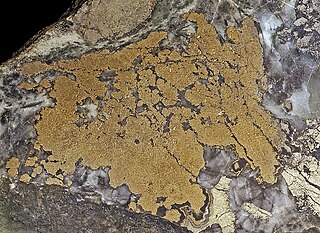
Nickeline or niccolite is a mineral consisting primarily of nickel arsenide (NiAs). The naturally-occurring mineral contains roughly 43.9% nickel and 56.1% arsenic by mass, but composition of the mineral may vary slightly.
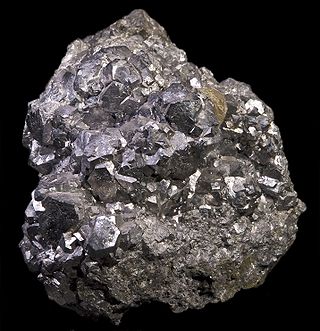
Named after Skuterudåsen, a hill in Modum, Norway, skutterudite is a cobalt arsenide mineral containing variable amounts of nickel and iron substituting for cobalt with the ideal formula CoAs3. Some references give the arsenic a variable formula subscript of 2–3. High nickel varieties are referred to as nickel-skutterudite, previously chloanthite. It is a hydrothermal ore mineral found in moderate to high temperature veins with other Ni-Co minerals. Associated minerals are arsenopyrite, native silver, erythrite, annabergite, nickeline, cobaltite, silver sulfosalts, native bismuth, calcite, siderite, barite and quartz. It is mined as an ore of cobalt and nickel with a by-product of arsenic.

Erythrite or red cobalt is a secondary hydrated cobalt arsenate mineral with the formula Co
3(AsO
4)
2•8H
2O. Erythrite and annabergite, chemical formula Ni
3(AsO
4)
2•8H
2O, or nickel arsenate form a complete series with the general formula (Co,Ni)
3(AsO
4)
2•8H
2O.

Cooperite is a grey mineral consisting of platinum sulfide, generally in combinations with sulfides of other elements such as palladium and nickel. Its general formula is (Pt,Pd,Ni)S. It is a dimorph of braggite.

Hellyerite, NiCO3·6(H2O), is an hydrated nickel carbonate mineral. It is light blue to bright green in colour, has a hardness of 2.5, a vitreous luster, a white streak and crystallises in the monoclinic system. The crystal habit is as platy and mammillary encrustations on its matrix.

Gaspéite, a very rare nickel carbonate mineral, with the formula (Ni,Fe,Mg)CO3, is named for the place it was first described, in the Gaspé Peninsula, Québec, Canada.

Otwayite, Ni2CO3(OH)2, is a hydrated nickel carbonate mineral. Otwayite is green, with a hardness of 4, a specific gravity of 3.4, and crystallises in the orthorhombic system.
Violarite (Fe2+Ni23+S4) is a supergene sulfide mineral associated with the weathering and oxidation of primary pentlandite nickel sulfide ore minerals.
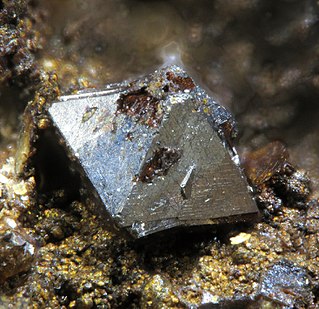
Polydymite, Ni2+Ni23+S4, is a supergene thiospinel sulfide mineral associated with the weathering of primary pentlandite nickel sulfide.

Spherocobaltite or sphaerocobaltite is a cobalt carbonate mineral with chemical composition CoCO3. In its (rare) pure form, it is typically a rose-red color, but impure specimens can be shades of pink to pale brown. It crystallizes in the trigonal crystal system.

Ashburtonite is a rare lead copper silicate-bicarbonate mineral with formula: HPb4Cu2+4Si4O12(HCO3)4(OH)4Cl.
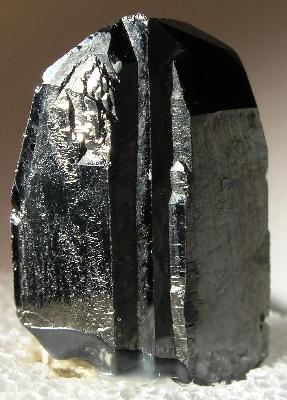
Wodginite is a manganese, tin, tantalum oxide mineral with the chemical formula Mn2+(Sn,Ta)Ta2O8. It may also include significant amounts of niobium.
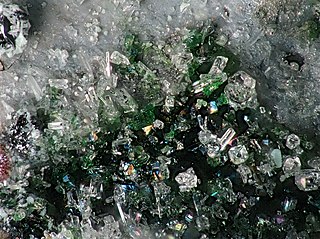
Bunsenite is the naturally occurring form of nickel(II) oxide, NiO. It occurs as rare dark green crystal coatings. It crystallizes in the cubic crystal system and occurs as well formed cubic, octahedral and dodecahedral crystals. It is a member of the periclase group.

Pecoraite is a nickel silicate mineral and a member of the serpentine group. It was named after geologist William Thomas Pecora. It is monoclinic and has a chemical composition of Ni3(Si2O5)(OH)4. It is associated with the weathering-and-or oxidation of meteorites or nickel sulfide minerals such as millerite. It is also found in altered ultramafic rocks. Pecoriate is typically a green, lime green, or bluegreen mineral with a waxy, or earthy luster and a mohs hardness of 2.5. Common textural habits associated with Pecoraite are curved plates, spirals and tubes. It can also be granular and massive.

Millerite is a nickel sulfide mineral, NiS. It is brassy in colour and has an acicular habit, often forming radiating masses and furry aggregates. It can be distinguished from pentlandite by crystal habit, its duller colour, and general lack of association with pyrite or pyrrhotite.
Manganoblödite is a rare manganese mineral with the formula Na2Mn(SO4)2·4H2O. Somewhat chemically similar mineral is D'Ansite-(Mn). Manganoblödite was found in the Blue Lizard mine, San Juan County, Utah, US, which is known for several relatively new secondary uranium minerals In the mine, manganoblödite occurs intimately intergrown with manganese-, cobalt- and nickel-enriched blödite and a yet another new mineral - cobaltoblödite. Manganoblödite, as suggested by its name is a manganese-analogue of blödite. It is also analogous to changoite, cobaltoblödite and nickelblödite - all three are members of the blödite group.
Cobaltoblödite is a rare cobalt mineral with the formula Na2Co(SO4)2·4H2O. Cobaltoblödite was found in the Blue Lizard mine, San Juan County, Utah, USA, which is known for secondary uranium minerals. Cobaltoblödite occurs intimately intergrown with manganese-, cobalt- and nickel-enriched blödite and a yet another new mineral - manganoblödite. Cobaltoblödite, as suggested by its name is a cobalt-analogue of blödite. It is also analogous to changoite, manganoblödite and nickelblödite - other members of the blödite group.
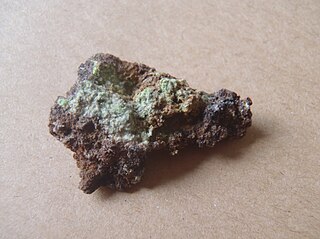
Nickelblödite is a rare nickel sulfate mineral with the formula Na2Ni(SO4)2·4H2O. Nickelblödite was discovered in nickel mines in Carr Boyd Rocks and Kambalda, Western Australia. The mineral is a nickel-analogue of blödite, changoite, cobaltoblödite and manganoblödite - other representatives of the blödite group.
Falcondoite, a member of the sepiolite group, was first discovered in the Dominican Republic, near the town of Bonao. The mineral was found in a deposit mined by Falconbridge Dominica, and so was named "falcondoite" after the company. Falcondoite is frequently associated with sepiolite, garnierite, talc, and serpentine, and is commonly nickel-bearing. While the chemical formula for falcondoite can vary, the mineral must contain more nickel than magnesium to be considered its own species. The ideal chemical formula for falcondoite is (Ni,Mg)4Si6O15(OH)2·6H2O.
















